Martienssen W., Warlimont H. (Eds.). Handbook of Condensed Matter and Materials Data
Подождите немного. Документ загружается.

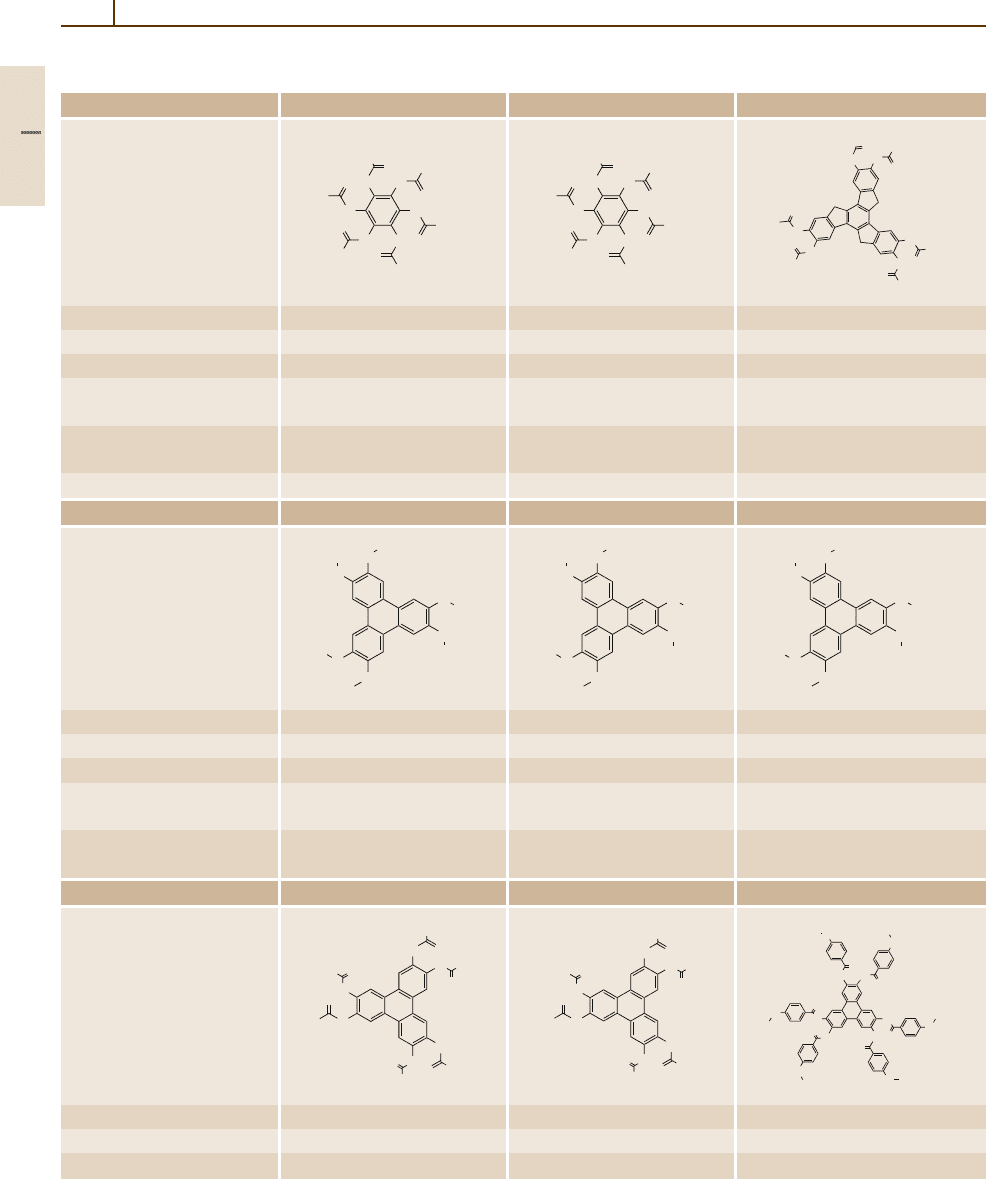
972 Part 5 Special Structures
Table 5.1-8 Discotic liquid crystals
Number/common name 163 164 165 (H10TX)
Substance
OO
O
O
O
O
O
O
O
O
O
O
H
13
C
6
C
6
H
13
C
6
H
13
C
6
H
13
H
13
C
6
H
13
C
6
OO
O
O
O
O
O
O
O
O
O
O
H
15
C
7
C
7
H
15
C
7
H
15
C
7
H
15
H
15
C
7
H
15
C
7
O
O
O
C
9
H
19
O
C
9
H
19
O
O
O
H
19
C
9
H
19
C
9
O
O
O
O
O
C
9
H
19
H
19
C
9
Formula C
48
H
78
O
12
C
54
H
90
O
12
C
87
H
126
O
12
Molar mass (g/mol) 847.15 931.312 1363.967
CAS-RN 65201-70-9 65201-71-0 86108-14-7
Temperatures of phase Cr 81.2D87.0Is Cr
28.8Cr82.0D84.0Is Cr 68 N 85 Drd 138 Dho 280 Is
transitions T
tr
(
◦
C)
Enthalpies of phase transitions 32.2 (Cr–D), 21.5 (D–Is) 46.1 (Cr–D), 19.2 (D–Is), 21.3 (Cr–N), 1.0 (N–D)
∆H
tr
(kJ/mol) 49.0(Cr
–Cr)
Refractive index n − − n
o
1.531, n
e
1.454 (T = 0.999T
N–D
)
Number/common name 166 (HAT5) 167 (HAT6) 168 (HAT8)
Substance
O
C
5
H
11
O
O
H
11
C
5
O
OH
11
C
5
O
C
5
H
11
H
11
C
5
C
5
H
11
O
C
6
H
13
O
O
H
13
C
6
O
OH
13
C
6
O
C
6
H
13
H
13
C
6
C
6
H
13
O
C
8
H
17
O
O
H
17
C
8
O
OH
17
C
8
O
C
8
H
17
H
17
C
8
C
8
H
17
Formula C
48
H
72
O
6
C
54
H
84
O
6
C
66
H
108
O
6
Molar mass (g/mol) 745.105 829.268 997.593
CAS-RN 69079-52-3 70351-86-9 70351-87-0
Temperatures of phase Cr 69.0 Dho 122.0Is Cr 68.0 Dho 97.0Is Cr 67.0 Dho 86.0Is
transitions T
tr
(
◦
C)
Enthalpies of phase transitions 32.6 (Cr–D), 8.1 (D–Is) 36.4 (Cr–D), 3.6 (D–Is) 83.3 (Cr–D), 4.2 (D–Is)
∆H
tr
(kJ/mol)
Number/common name 169 170 (HAT11) 171
Substance
O
OO
O
O
O
O
O
O
C
7
H
15
O
C
7
H
15
H
15
C
7
OH
15
C
7
C
7
H
15
C
7
H
15
O
O
OO
O
O
O
O
O
O
C
11
H
23
O
H
23
C
11
H
23
C
11
OH
23
C
11
C
11
H
23
C
11
H
23
O
O
O
O
OO
O
O
O
O
O
O
O
O
O
O
O
O
O
H
15
C
7
C
7
H
15
C
7
H
15
C
7
H
15
H
15
C
7
H
15
C
7
Formula C
66
H
96
O
12
C
90
H
144
O
12
C
102
H
120
O
18
Molar mass (g/mol) 1081.494 1418.144 1634.083
CAS-RN 70351-94-9 70187-34-7 75747-38-5
Part 5 1.2
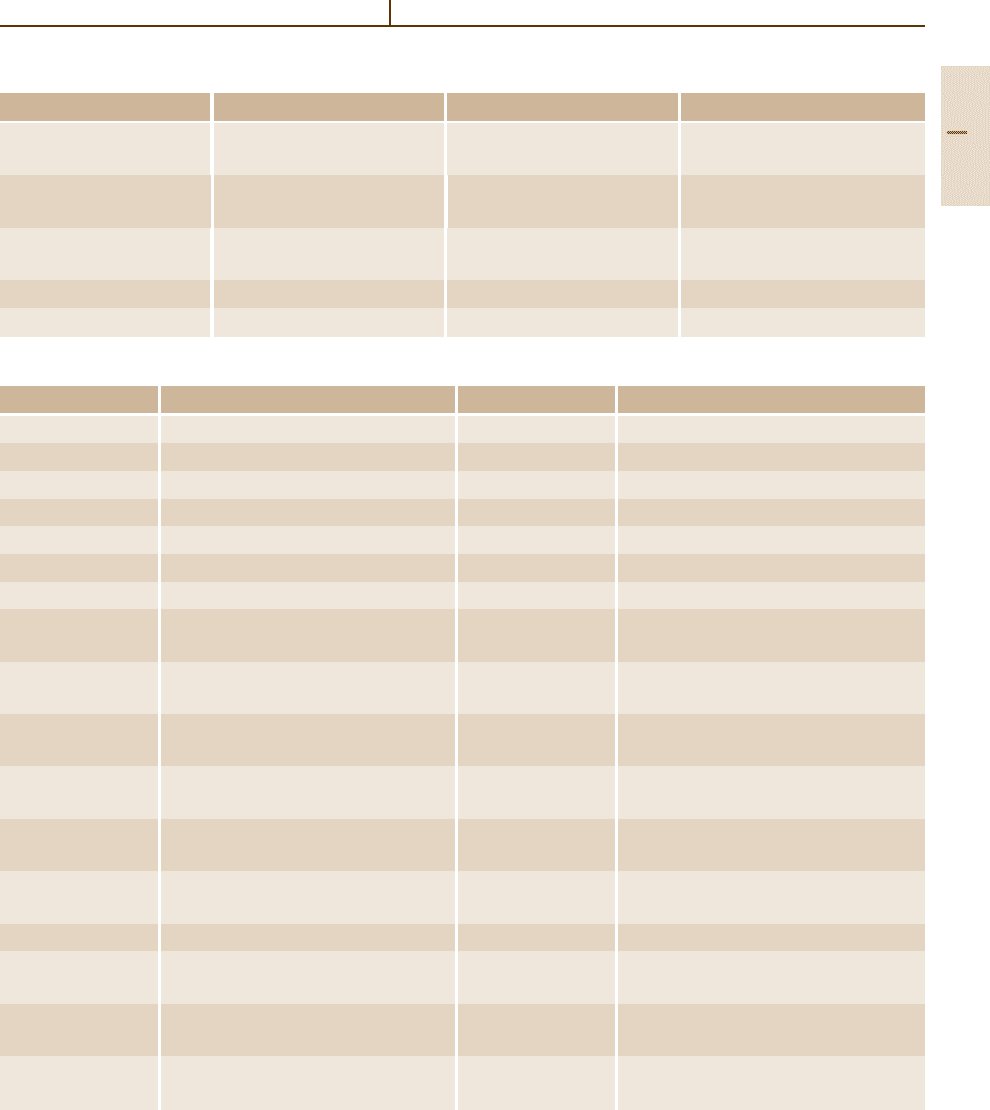
Liquid Crystals 1.2 Physical Properties of the Most Common Liquid Crystalline Substances 973
Table 5.1-8 Discotic liquid crystals, cont.
Number/common name 169 170 (HAT11) 171
Temperatures of phase Cr 66.0 D 126.0Is Cr 80.0Dh93.0 Dt 111.0 Cr
117.8Cr
130.9 Cr 169.1
transitions T
tr
(
◦
C) Dh 122.3Is N 253.1Is
Enthalpies of phase transitions 19.7 (Cr–D), 2.8 (D–Is) 59.4 (Cr–D), 2.4 (D–Is) 9.4 (Cr–D)
∆H
tr
(kJ/mol)
Anisotropy of refractive index − − −0.09 (200
◦
C, 633 nm)
∆n
Dielectric constant ε − − ε
3.78, ε
⊥
3.33 (230
◦
C)
Dynamic viscosity η (mPa s) − − 350 (230
◦
C)
Table 5.1-9 Liquid crystal salts
Na
+
Temperatures of phase transitions (
◦
C) Tl
+
Temperatures of phase transitions (
◦
C)
C
3
H
7
−
COO−
Cr 251.0 S 327.0Is C
4
H
9
−
COO−
Cr 80.4 S 180.0 A 214.3Is
C
4
H
9
−
COO−
Cr 241.0 A 344.0Is C
5
H
11
−
COO−
Cr 124.4 S 137.2 S 148.5 A 227.1Is
C
5
H
11
−
COO−
Cr 210.0 S 235.0 A 361.0Is C
6
H
13
−
COO−
Cr 140.5 A 226.0Is
C
6
H
13
−
COO−
Cr 198.0 S 242.0 A 363.0Is C
7
H
15
−
COO−
Cr 135.0 A 221.0Is
C
7
H
15
−
COO− Cr 189.0 S 243.0 A 360.0Is C
8
H
17
−
COO− Cr 39.5S55.8 S 136.5 A 217.9Is
C
8
H
17
−
COO−
Cr 185.0 S 243.0 A 355.0Is C
9
H
19
−
COO−
Cr 30.2S49.8 S 128.4 A 207.6Is
C
9
H
19
−
COO− Cr 140.0 S 181.0 S 245.0 S 348.0Is C
10
H
21
−
COO− Cr 35.8S47.0S74.4 S 128.7 A 201.6Is
C
10
H
21
−
COO− Cr 115.0 S 145.0 S 167.0 S 187.0 S 242.0 C
11
H
23
−
COO− Cr 36.0S73.8 S 122.3 A 196.8Is
A 337.0Is
C
11
H
23
−
COO− Cr 100.0 S 141.0 S 182.0 S 220.0 S 255.0 C
12
H
25
−
COO− Cr 53.8S58.6S97.0 S 125.3 A 192.5Is
A 336.0Is
C
12
H
25
−
COO− Cr 121.0 S 162.0 S 187.0 S 200.0 S 217.0 C
13
H
27
−
COO− Cr 36.5S42.0S94.8 S 118.9 A 184.4Is
S 248.0 A 323.0Is
C
13
H
27
−
COO− Cr 113.0 S 138.0 S 171.0 S 215.0 S 246.0 C
14
H
29
−
COO− Cr 66.9 S 111.6 S 120.4 A 179.6Is
A 311.0Is
C
14
H
29
−
COO− Cr 121.0 S 160.0 S 187.0 S 203.0 S 251.0 C
15
H
31
−
COO− Cr 54.0 S 114.4 S 116.4 A 175.5Is
S 277.0 A 307.0Is
C
15
H
31
−
COO− Cr 117.0 S 136.0 S 168.0 S 212.0 S 251.0 C
16
H
33
−
COO− Cr 75.3 S 119.4 A 171.5Is
A 302.0Is
C
16
H
33
−
COO− Cr 130.0 S 205.0 S 260.0 A 290.0Is C
17
H
35
−
COO− Cr 62.1 S 118.4 A 168.1Is
C
17
H
35
−
COO− Cr 117.0 S 132.0 S 167.0 S 198.0 S 257.0 C
19
H
39
−
COO− Cr 70.2 S 120.5 A 158.2Is
A 288.0Is
C
18
H
37
−
COO− Cr 118.0 S 133.0 S 146.0 S 193.0 S 202.0 C
21
H
43
−
COO− Cr 67.2S76.8 S 121.8 A 151.8Is
S 258.0 A 283.0Is
C
19
H
39
−
COO− Cr 110.0 S 131.0 S 163.0 S 200.0 C
25
H
51
−
COO− Cr 114.0 S 125.0Is
A 262.0Is
Part 5 1.2
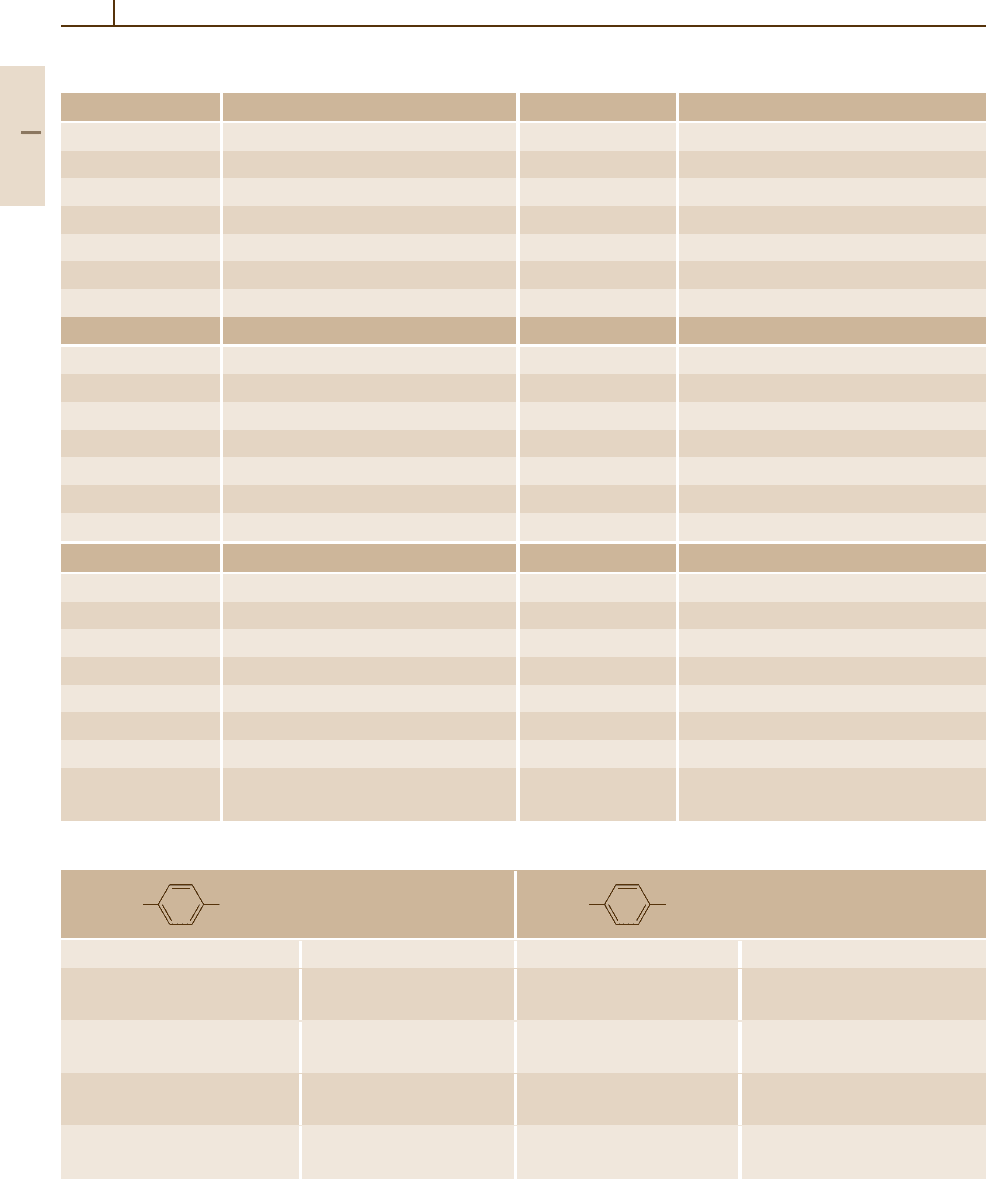
974 Part 5 Special Structures
Table 5.1-9 Liquid crystal salts, cont.
Li
+
Temperatures of phase transitions (
◦
C) K
+
Temperatures of phase transitions (
◦
C)
C
11
H
23
−
COO−
Cr 229.0 S 239.0Is C
3
H
7
−
COO−
Cr 353.0 S 404.0Is
C
12
H
25
−
COO− Cr 224.0 S 232.0Is C
4
H
9
−
COO− Cr 313.4 S 443.0Is
C
13
H
27
−
COO− Cr 210.0 S 231.0 S 239.0Is C
5
H
11
−
COO− Cr 308.5 S 452.0Is
C
14
H
29
−
COO−
Cr 206.0 S 229.0Is C
6
H
13
−
COO−
Cr 298.1 S 449.0Is
C
15
H
31
−
COO− Cr 197.0 S 215.0 S 223.0Is C
7
H
15
−
COO− Cr 287.0 S 439.0Is
C
17
H
35
−
COO−
Cr 190.0 S 215.0 S 229.0Is C
8
H
17
−
COO−
Cr 276.0 S 434.0Is
C
19
H
39
−
COO−
Cr 189.0 S 226.0Is C
9
H
19
−
COO−
Cr 271.0 S 423.0Is
Cs
+
Temperatures of phase transitions (
◦
C) C
10
H
21
−
COO−
Cr 268.0 S 418.0Is
C
5
H
11
−
COO−
Cr 359.0 S 399.0Is C
11
H
23
−
COO−
Cr 268.0 S 406.0Is
C
6
H
13
−
COO−
Cr 345.0 S 421.0Is C
12
H
25
−
COO−
Cr 89.9 S 397.6Is
C
7
H
15
−
COO−
Cr 334.0 S 425.0Is C
13
H
27
−
COO−
S 271.0 A 375.0Is
C
8
H
17
−
COO−
Cr 325.0 S 424.0Is C
14
H
29
−
COO−
Cr 64.0 S 388.5Is
C
9
H
19
−
COO− Cr 314.0 S 415.0Is C
15
H
31
−
COO− Cr 195.0 S 269.0 A 362.0Is
C
11
H
23
−
COO−
Cr 278.0 S 355.0Is C
17
H
35
−
COO−
Cr 170.0 S 238.0 S 264.0 S 356.0Is
C
13
H
27
−
COO−
Cr 287.0 S 386.0Is C
19
H
39
−
COO−
Cr 74.1 S 339.9Is
Rb
+
Temperatures of phase transitions (
◦
C) Cu
2+
Temperatures of phase transitions (
◦
C)
C
4
H
9
−
COO−
Cr 367.0 S 430.0Is C
3
H
7
−
COO−
Cr 195.0D > 200.0 dec
C
5
H
11
−
COO− Cr 342.2 S 450.0Is C
4
H
9
−
COO− Cr 111.0D > 200.0 dec
C
6
H
13
−
COO− Cr 327.0 S 451.0Is C
5
H
11
−
COO− Cr 95.0D> 200.0 dec
C
7
H
15
−
COO−
Cr 312.0 A 440.0Is C
6
H
13
−
COO−
Cr 93.0D> 200.0 dec
C
8
H
17
−
COO− Cr 300.0 A 439.0Is C
7
H
15
−
COO− Cr 88.0D> 200.0 dec
C
9
H
19
−
COO− Cr 291.0 A 429.0Is C
8
H
17
−
COO− Cr 102.0D > 200.0 dec
C
11
H
23
−
COO− Cr 300.0 A 400.0Is C
9
H
19
−
COO− Cr 106.9 D 210.0 dec
C
13
H
27
−
COO− Cr 212.4 S 217.9 S 240.3 S 277.6 C
15
H
31
−
COO− Cr 122.0 D 220.0 dec
S 394.0Is
Table 5.1-9 Liquid crystal salts, cont.
L R L R
H
−−
C
3
H
6
−
COO
−
Tl Cr 58.4A62.4Is C
5
H
11
−
O
−−
COO
−
Tl Cr 160.0 S 294.0 A 344.0Is
H
−−
C
5
H
10
−
COO
−
Tl Cr 34.0A93.0Is C
6
H
13
−
O
−−
COO
−
Tl Cr 27.0 S 114.0 S 284.0
A 343.0Is
H
−−
C
7
H
14
−
COO
−
Tl Cr 39.0 A 107.5Is C
7
H
15
−
O
−−
COO
−
Tl Cr 36.0S57.0 S 121.0 S 274.0
A 334.0Is
H
−−
C
9
H
18
−
COO
−
Tl Cr 51.0 A 114.0Is C
8
H
17
−
O
−−
COO
−
Tl Cr 30.0S43.0 S 131.0 S 269.0
A 330.0Is
C
6
H
13
−−
COO
−
Tl Cr 118.0 S 264.0 A 334.0Is C
9
H
19
−
O
−−
COO
−
Tl Cr 57.0S62.0 S 135.0 S 264.0
A 322.0Is
Part 5 1.2
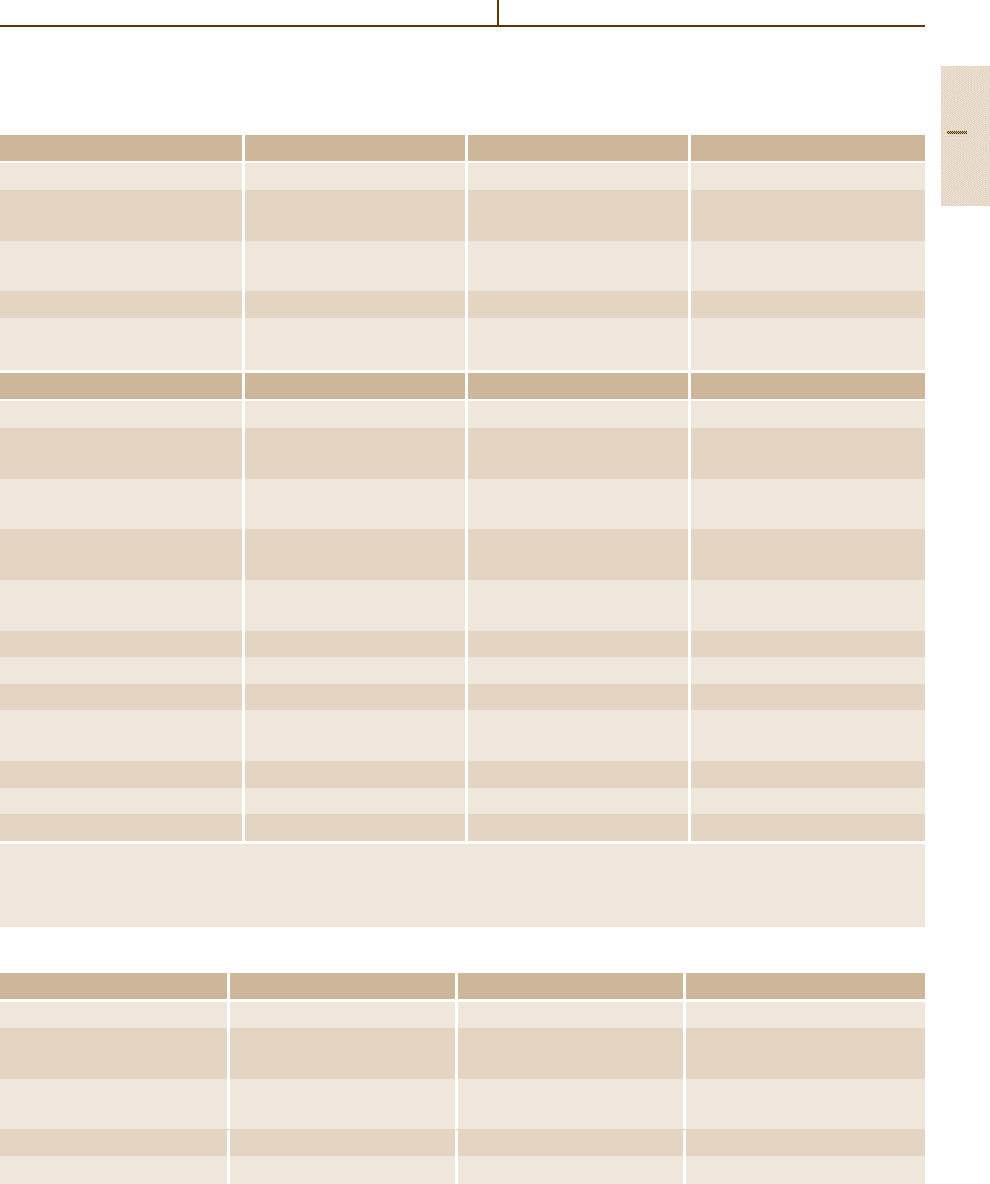
Liquid Crystals 1.3 Physical Properties of Some Liquid Crystalline Mixtures 975
5.1.3 Physical Properties of Some Liquid Crystalline Mixtures
Table 5.1-10 Nematic mixtures
Mixture E49 (Merck) ZLI-2857 (Merck) ZLI-3086 (Merck)
Components Cyanobiphenyls
Temperatures of phase Cr −9 N 100 Is Cr −19N82.3Is N72.0Is
transitions T
tr
(
◦
C)
Anisotropy of refractive index ∆n 0.251 0.0776 0.1131
(20
◦
C)
Dielectric anisotropy ∆ε (20
◦
C) −1.4 0.1
Kinematic viscosity 46.5 20
(mm
2
/s) (20
◦
C)
Mixture E7 (Merck) ZLI-1132 (Merck) ZLI-4792 (Merck)
Components Cyanobiphenyls Phenylcyclohexanes Fluorinated LCs
Temperatures of phase Cr <−30N58Is Cr −6N71Is Cr <−40N92Is
transitions T
tr
(
◦
C)
Anisotropy of refractive index ∆n 0.2253 0.1396 0.0969
(589 nm, 20
◦
C)
Extraordinary refractive index n
e
1.7464 1.6326 1.5763
(589 nm, 20
◦
C)
Dielectric anisotropy ∆ε 13.8 13.1 5.2
(1 kHz, 20
◦
C)
ε
(1 kHz, 20
◦
C) 19.0 17.7 8.3
Kinematic viscosity (mm
2
/s) 39 (20
◦
C), 145 (0
◦
C) 28 (20
◦
C), 110 (0
◦
C) 15 (20
◦
C), 40 (0
◦
C)
Surface tension (mN/m) 29.3(22
◦
C), σ
⊥
14.5, σ
23.7 31.0(22
◦
C), σ
⊥
13.6, σ
26.0 −
Elastic-constants ratio 1.54 1.95 1.39
K
3
/K
1
(20
◦
C)
V
10
(V) threshold 1.41 1.77 2.00
V
50
(V) 1.63 2.05 2.47
V
90
(V) saturation 1.99 2.49 3.15
Data have been taken from [1.5]. ZLI-4792 is an SFM (superfluorinated material); it is recommended for VIP (viewing-independent panel)
twisted nematic displays. Mixtures E7 and ZLI-1132 are recommended for usage in calculators, wristwatches, and measuring instruments.
V
10
, V
50
, and V
90
are voltages at 10, 50, and 90%, respectively, of the maximum absorption at 0
◦
viewing angle and 20
◦
C.
Table 5.1-11 Ferroelectric mixtures
Mixture CS1024 CS2004 CS4000
CAS-RN 123967-01-1 135976-66-8 150260-44-9
Temperatures of phase Cr −12 C* 62 A 82 N* 90 Is Cr <20 C* 62 N* 71 Is Cr −10 CA 70.5Cγ 72.5C*74.6
transitions T
tr
(
◦
C) Cα 75.6 A 100 Is
Spontaneous polarization P
s
−46.9 − −
(25
◦
C) (nC/cm
2
)
Tilt Θ (25
◦
C) 25 44 −
Pitch (µm) >20 − −
Part 5 1.3
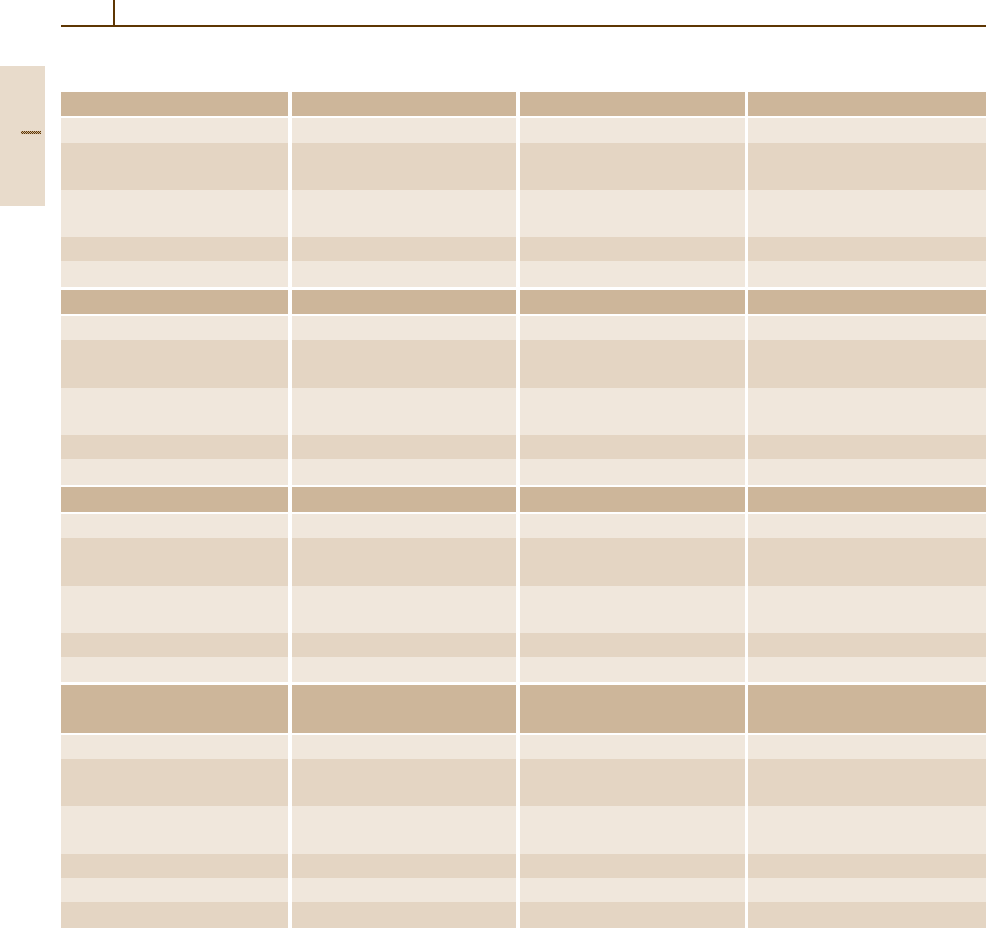
976 Part 5 Special Structures
Table 5.1-11 Ferroelectric mixtures, cont.
Mixture Felix-015-100 SCE8 SCE9
CAS-RN 211365-96-7 145380-16-1 126879-69-4
Temperatures of phase Cr −12C*72A83N*86Is Cr <20 C 59 A 79 N 100 Is Cr <20 C* 61 A 91 N* 115 Is
transitions T
tr
(
◦
C)
Spontaneous polarization P
s
+33 +630 −
(25
◦
C) (nC/cm
2
)
Tilt Θ (25
◦
C) 25.5 − −
Switching time τ (25
◦
C) − 294 µs −
Mixture SCE10 SCE13 TKF 8617
CAS-RN 134499-04-0 133758-42-6 114899-67-1
Temperatures of phase Cr <20 C* 61 N* 109 Is Cr <0 C* 61 A 86 N* 103 Is Cr4C*54A65Is
transitions T
tr
(
◦
C)
Spontaneous polarization P
s
19.5 30.6 −
(20
◦
C) (nC/cm
2
)
Tilt Θ (20
◦
C) − 29 −
Pitch (µm) − 10–12 −
Mixture W22 ZhKS-309C ZLI-3654
CAS-RN 137988-43-3 205599-65-1 116580-90-6
Temperatures of phase Cr4C*51A82N*92Is Cr −1C*42A91Is Cr −30 C* 62 A 76 N 86 Is
transitions T
tr
(
◦
C)
Spontaneous polarization P
s
− +50.8 −29
(20
◦
C) (nC/cm
2
)
Tilt Θ (20
◦
C) − 26 −
Pitch (µm) − 0.4 3
Mixture ZLI-4655-000 ZLI-4851-100, ZLI-5014-100
Felix-M-4851-100
CAS-RN 139352-77-5 158854-82-1 172452-16-3
Temperatures of phase Cr <10C*60A69N*72Is Cr <−20 C* 67 A 71 N* 76 Is Cr <−10C*65A70N*72Is
transitions T
tr
(
◦
C)
Spontaneous polarization P
s
+7 +22.8 −20
(20
◦
C) (nC/cm
2
)
Tilt Θ (20
◦
C) − 30.5 −
Pitch (µm) − − 10
Switching time τ (20
◦
C) − 38 µs 3 µs
Part 5 1.3

Liquid Crystals References 977
References
1.1 D. Demus, H. Demus, H. Zaschke: Flüssige Kristalle in
Tabellen I (VEB Deutscher Verlag Grundstoffindustrie,
Leipzig 1974)
1.2 D. Demus, H. Zaschke: Flüssige Kristalle in Tabellen
II (Deutscher Verlag Grundstoffindustrie, Leipzig
1982)
1.3 V. Vill: Liquid Crystals, Landolt–Börnstein, New Se-
ries IV/7 (Springer, Berlin, Heidelberg 1992 – 1995)
1.4 V. Vill: Liqcryst 4.3 - Database of liquid crys-
talline compounds, http://liqcryst.chemie.uni-
hamburg.de/ (2003)
1.5 Merck: Product information, liquid crystal mixtures
for electro-optic displays (Merck, Darmstadt 1992)
1.6 H. Kelker, R. Hatz: Handbook of Liquid Crystals (Ver-
lag Chemie, Weinheim 1980)
1.7 A. Beguin, J. C. Dubois, P. Le Barny, J. Billard,
F. Bonamy, J. M. Buisine, P. Cuvelier: Sources of
thermodynamic data on mesogens, Mol. Cryst. Liq.
Cryst. 115,1(1984)
1.8 BDH Chemical: Product information (BDH, Poole
1986)
1.9 E. Merck: Product information (Merck, Darmstadt
1986)
1.10 S. Chandrasekhar: Liquid Crystals (Cambridge Univ.
Press, Cambridge 1992)
1.11 D. Demus, J. Goodby, G. W. Gray, H.-W. Spiess, V. Vill
(Eds.): Handbook of Liquid Crystals, Vol. I – III (Wiley-
VCH, Weinheim 1998)
1.12 D. Demus, J. Goodby, G. W. Gray, H.-W. Spiess, V. Vill
(Eds.): Physical Properties of Liquid Crystals (Wiley-
VCH, Weinheim 1999)
1.13 V. G. Chigrinov: Liquid Crystal Devices: Physics and
Applications (Artech House, Boston 1999)
1.14 S. Pestov: Physical Properties of Liquid Crys-
tals, Landolt–Börnstein, New Series VIII/5 (Springer,
Berlin, Heidelberg 2003)
1.15 D. Demus, R. Richter: Textures of Liquid Crystals
(Verlag Chemie, Weinheim 1978)
1.16 G. W. Gray, J. W. G. Goodby: Smectic Liquid Crystals
– Textures and Structures (Hill, Glasgow 1984)
1.17 Hoffmann-La Roche: Product information (Hoff-
mann-La Roche, Basel 1988)
Part 5 1

978
This page intentionally left blank
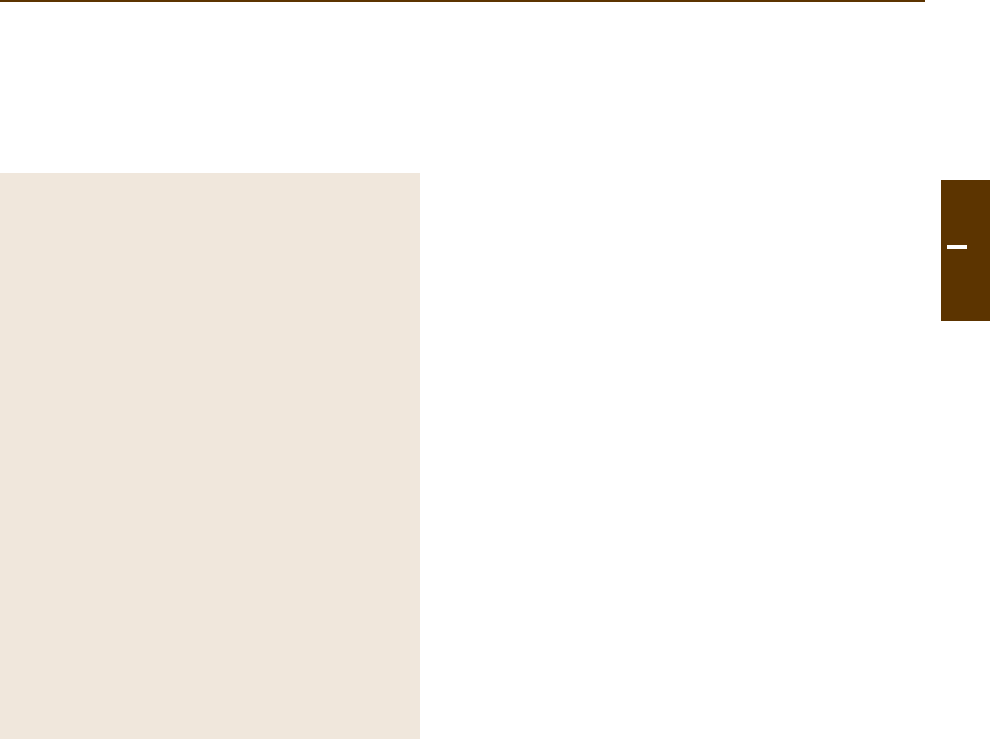
979
The Physics of
5.2. The Physics of Solid Surfaces
The data compiled in this chapter refer to so-called
“clean surfaces”, i. e. crystalline surfaces that are
atomically clean and well characterized. Data
on interfaces are dealt with only marginally, in
connection with MOS devices.
The values reported in the tables are mainly
averages from several different authors. In such
cases the errors are given as standard deviations.
Reference to the individual measurements and to
the original papers is made by referring to larger
compilations (mainly the four volumes of Landolt–
Börnstein III/24, Physics of Solid Surfaces,[2.1]or
the single articles therein [2.2–16]). On the other
hand, the figures are fully referenced.
5.2.1 The Structure of Ideal Surfaces............. 979
5.2.1.1 Diagrams of Surfaces [2.2] ........ 979
5.2.1.2 Crystallographic Formulas......... 986
5.2.2 Surface Reconstruction and Relaxation. 986
5.2.2.1 Definitions and Notation.......... 986
5.2.2.2 Metals ................................... 987
5.2.2.3 Semiconductors ...................... 987
5.2.3 Electronic Structure of Surfaces ............ 996
5.2.3.1 Metals ................................... 997
5.2.3.2 Semiconductors ...................... 1003
5.2.3.3 Magnetic Surfaces ................... 1007
5.2.4 Surface Phonons................................. 1012
5.2.4.1 Metals ................................... 1012
5.2.4.2 Semiconductors
and Insulators ........................ 1017
5.2.4.3 Atom–Surface Potential ........... 1019
5.2.5 The Space Charge Layer at the Surface
of a Semiconductor............................. 1020
5.2.5.1 Definitions and Notation.......... 1020
5.2.5.2 Useful Formulas
and Numerical Values .............. 1022
5.2.5.3 Surface Conductivity ................ 1023
5.2.6 Most Frequently Used Acronyms ........... 1026
References ..................................................1029
5.2.1 The Structure of Ideal Surfaces
An ideal surface is a surface of a half-crystal in which
the atoms are held in their original positions. The struc-
ture of an ideal surface is identical to that of a parallel
crystallographic plane in the bulk. For a 2-D lattice, the
elementary Bravais cell can have only one of the five
structures shown in Fig. 5.2-1.
5.2.1.1 Diagrams of Surfaces [2.2]
Figure 5.2-2 gives diagrams of ideal surfaces for some
common faces of the fcc (face-centered cubic), bcc
(body-centered cubic), diamond, and zinc blende sys-
tems, as well as the coordinates of the atoms of the
first layers of the half-crystal. The atoms are drawn as
solid balls with diameters appropriate to close-packed
stacking.
Atoms in the surface layer are labeled by O, A, B,
C, ... . Atoms in the first, second, third, etc. sublayer
are labeled by 1, 2, 3, ... . When two classes of atoms
are present (for example in diamond-like structures),
the atoms of the second class are indicated by primed
symbols. In such a case, the division of an ideal crys-
tal by a geometrical plane may expose different types
of surfaces. A well-known example is the (111) face
of NaCl-type crystals, which may be either anion- or
cation-terminated.
Part 5 2
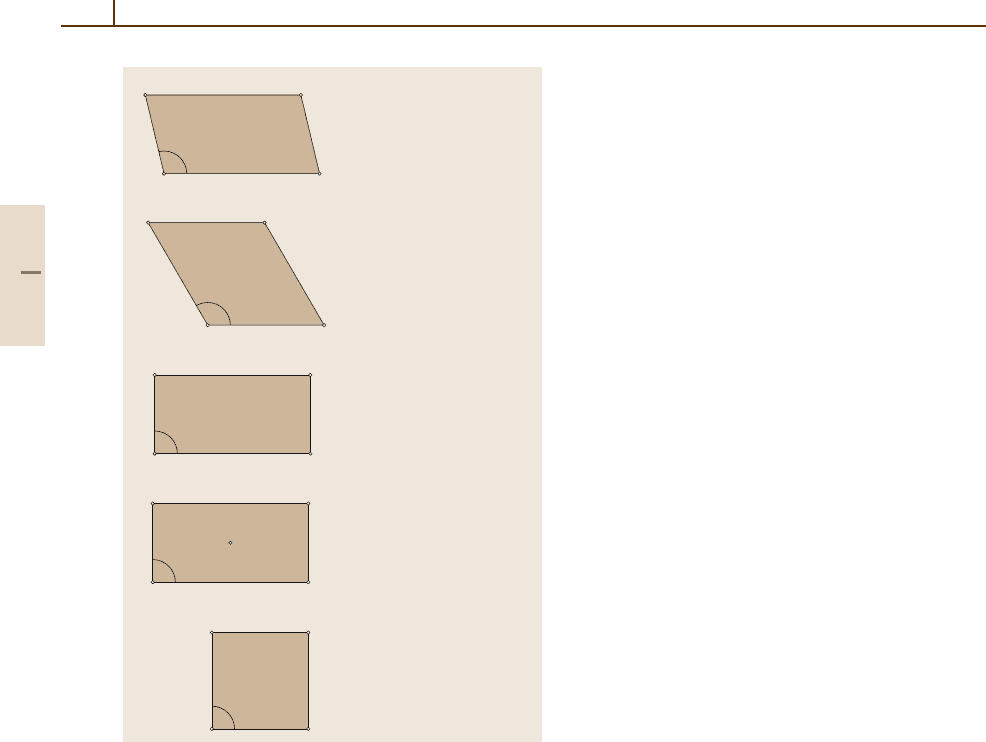
980 Part 5 Special Structures
a
1
= a
2
θ = 120°
Hexagonal
a
1
θ
a
1
a
2
θ
a
1
a
2
θ
a
1
θ
a
2
a
1
= a
2
θ =90°
Square
a
1
a
2
θ =90°
Centered rectangular
a
1
≠ a
2
θ =90°
Primitive rectangular
a
2
a
1
a
2
θ
a
1
≠ a
2
θ > 90° (if a
1
= a
2
the condition θ ≠ 120°
must be satisfied)
Oblique
Fig. 5.2-1 Elementary Bravais cells for a 2D lattice
A parameter δ,0≤ δ<1, is introduced to specify
the distance from the dividing plane to the nearest plane
through lattice points.
Coordinates are referred either to crystal axes (Oxyz)
or to asystem OXYZ,inwhichXY are axesin the surface
plane; X is parallel to a side of the 2-D Bravais cell and
Z is perpendicular to the surface.
Coordinates are always givenin terms of a/2, a being
the lattice parameter.
A more detailed discussion of the structure of ideal
surfaces and many other diagrams of surfaces can be
found in [2.2].
Part 5 2.1
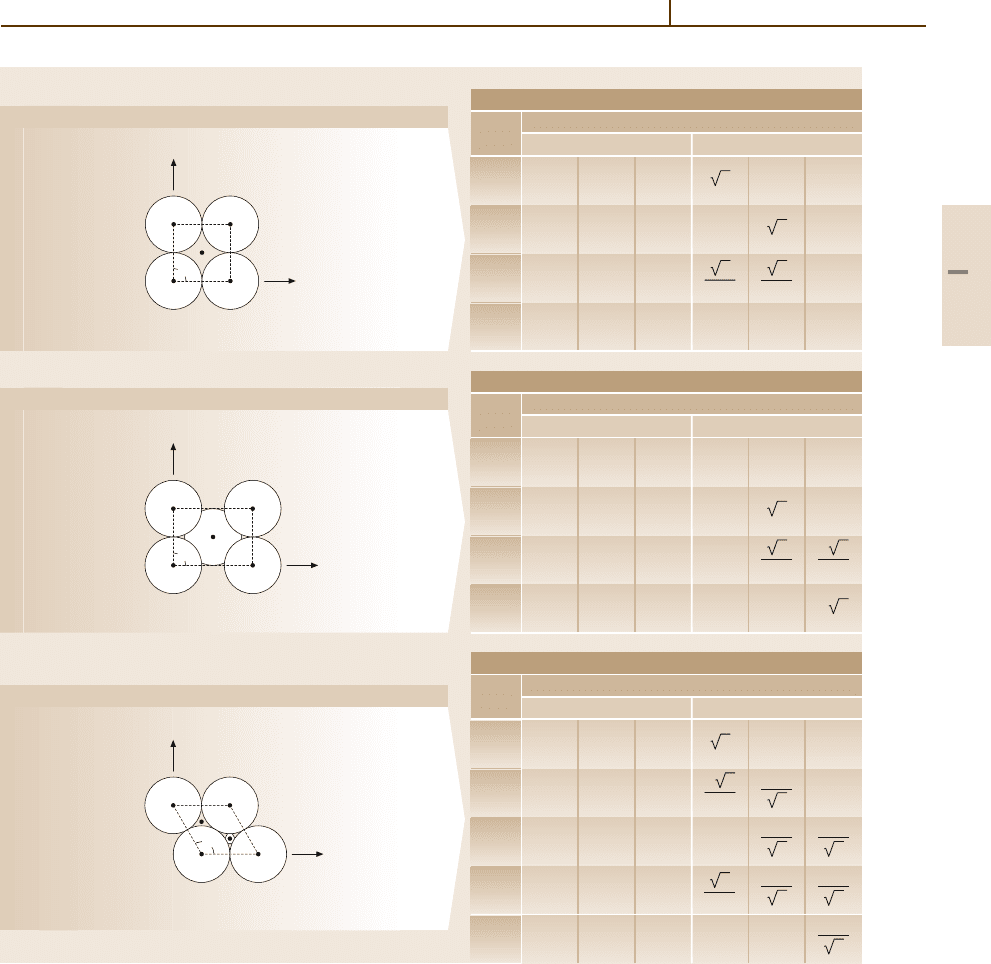
The Physics of Solid Surfaces 2.1 The Structure of Ideal Surfaces 981
Θ
Y
[011]
X
[01
-
1]
Θ = 90°
2
0
0
–1
–2
1
1
1
0
–1
1
0
0
00
0
2
0
–1
–200
Relative to cubic axes Relative to OXYZ
Atom
Coordinates
Atomic positions
A
B
1
2
2
2
2
2
0
1
0
–1
–1
–1
–1
0
0
0
0
00
000
11
22
2
–
2
Relative to cubic axes Relative to OXYZ
Atom
Coordinates
Atomic positions
A
B
1
2
–
2
2
2
2
0
00
00
0
00
–1
–2 –2
–2
–1
01
–1 1
–1
–1
–1
–2
2
3
Relative to cubic axes Relative to OXYZ
Atom
Coordinates
Atomic positions
A
B
1
2
–
2
2
2
2
3
6
2
6
1
6
–2
3
–4
3
–6
3
fcc (100)
fcc (110)
B
C
O, 2
A
1
fcc (111)
Θ
Y
[1
-
10]
X
[001]
Θ = 90°
B C
O, 2
A
1
Θ
Y
[2
-
1
-
1]
Θ = 120°
X
[0
-
11]
B C
O, 3
A
1
2
a)
Fig. 5.2-2 (a) Surface diagrams: face-centered cubic (fcc) positions given in terms of a/2 [2.2] (b) Surface diagrams:
body-centered cubic (bcc) positions given in terms of a/2 [2.2]
(c) Surface diagrams: diamond, GaAs (positions given in
terms of a/2) Ga atoms are denoted by unprimed symbols; As atoms by primed symbols and shaded circles [2.2]
Part 5 2.1
